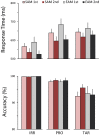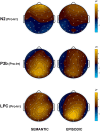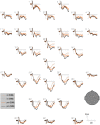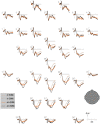Concealed semantic and episodic autobiographical memory electrified
- PMID: 23355816
- PMCID: PMC3553422
- DOI: 10.3389/fnhum.2012.00354
Concealed semantic and episodic autobiographical memory electrified
Abstract
Electrophysiology-based concealed information tests (CIT) try to determine whether somebody possesses concealed information about a crime-related item (probe) by comparing event-related potentials (ERPs) between this item and comparison items (irrelevants). Although the broader field is sometimes referred to as "memory detection," little attention has been paid to the precise type of underlying memory involved. This study begins addressing this issue by examining the key distinction between semantic and episodic memory in the autobiographical domain within a CIT paradigm. This study also addresses the issue of whether multiple repetitions of the items over the course of the session habituate the brain responses. Participants were tested in a 3-stimulus CIT with semantic autobiographical probes (their own date of birth) and episodic autobiographical probes (a secret date learned just before the study). Results dissociated these two memory conditions on several ERP components. Semantic probes elicited a smaller frontal N2 than episodic probes, consistent with the idea that the frontal N2 decreases with greater pre-existing knowledge about the item. Likewise, semantic probes elicited a smaller central N400 than episodic probes. Semantic probes also elicited a larger P3b than episodic probes because of their richer meaning. In contrast, episodic probes elicited a larger late positive complex (LPC) than semantic probes, because of the recent episodic memory associated with them. All these ERPs showed a difference between probes and irrelevants in both memory conditions, except for the N400, which showed a difference only in the semantic condition. Finally, although repetition affected the ERPs, it did not reduce the difference between probes and irrelevants. These findings show that the type of memory associated with a probe has both theoretical and practical importance for CIT research.
Keywords: ERPs (event-related potentials); concealed information; deception; deception detection; episodic memory; semantic memory.
Figures







Similar articles
-
Is anterior N2 enhancement a reliable electrophysiological index of concealed information?Neuroimage. 2016 Dec;143:152-165. doi: 10.1016/j.neuroimage.2016.08.042. Epub 2016 Aug 26. Neuroimage. 2016. PMID: 27570109
-
Personal semantics: Is it distinct from episodic and semantic memory? An electrophysiological study of memory for autobiographical facts and repeated events in honor of Shlomo Bentin.Neuropsychologia. 2016 Mar;83:242-256. doi: 10.1016/j.neuropsychologia.2015.08.013. Epub 2015 Aug 13. Neuropsychologia. 2016. PMID: 26277459
-
Detecting concealed information using feedback related event-related brain potentials.Brain Cogn. 2014 Oct;90:142-50. doi: 10.1016/j.bandc.2014.06.012. Epub 2014 Jul 21. Brain Cogn. 2014. PMID: 25058495
-
[Functional neuroanatomy of the autobiographical memory].J Soc Biol. 2001;195(4):343-9. J Soc Biol. 2001. PMID: 11938549 Review. French.
-
[Episodic autobiographical memory in depression: a review].Encephale. 2006 Oct;32(5 Pt 1):781-8. doi: 10.1016/s0013-7006(06)76231-5. Encephale. 2006. PMID: 17099603 Review. French.
Cited by
-
Semantic Activation in Badminton Action Processing and Its Modulation by Action Duration: An ERP Study.Brain Sci. 2022 Oct 27;12(11):1458. doi: 10.3390/brainsci12111458. Brain Sci. 2022. PMID: 36358384 Free PMC article.
-
Deception research today.Front Psychol. 2014 Mar 25;5:256. doi: 10.3389/fpsyg.2014.00256. eCollection 2014. Front Psychol. 2014. PMID: 24723905 Free PMC article. No abstract available.
-
False memories in forensic psychology: do cognition and brain activity tell the same story?Front Psychol. 2024 May 16;15:1327196. doi: 10.3389/fpsyg.2024.1327196. eCollection 2024. Front Psychol. 2024. PMID: 38827889 Free PMC article. Review.
References
-
- Allen J. J., Iacono W. G., Danielson K. D. (1992). The identification of concealed memories using the event-related potential and implicit behavioral measures: a methodology for prediction in the face of individual differences. Psychophysiology 29, 504–522 - PubMed
-
- Barrett S. E., Rugg M. D. (1989). Event-related potentials and the semantic matching of faces. Neuropsychologia 27, 913–922 - PubMed
-
- Barrett S. E., Rugg M. D. (1990). Event-related potentials and the semantic matching of pictures. Brain Cogn. 14, 201–212 - PubMed
LinkOut - more resources
Full Text Sources
Other Literature Sources

